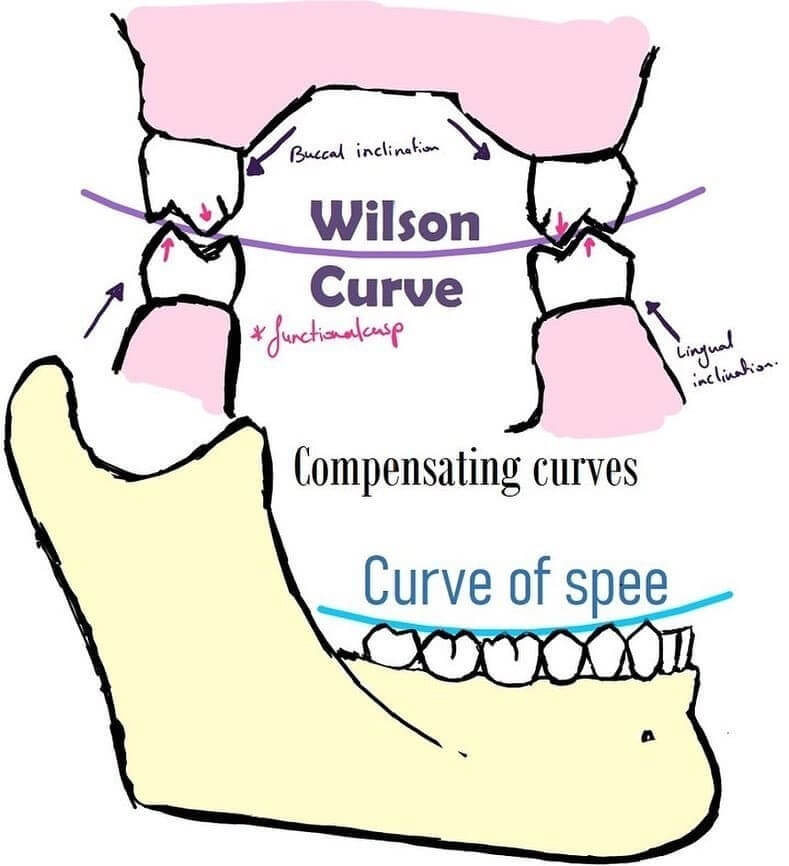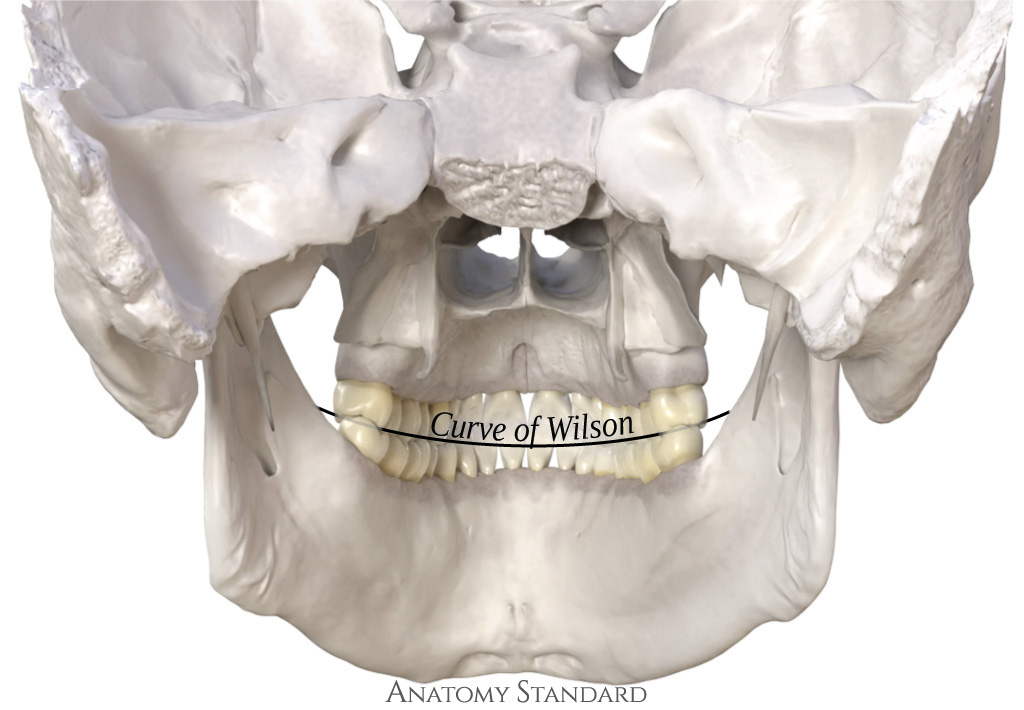Is the seemingly subtle curve of our teeth a pivotal player in the complex dance of chewing and jaw movement? The Curve of Wilson, a crucial yet often overlooked component of dental anatomy, shapes not only our smiles but also the very mechanics of how we eat and speak. This article delves into the intricacies of this fascinating curve, exploring its significance in dentistry and its impact on our overall oral health.
The Curve of Wilson, in essence, is the mediolateral curvature observed in the occlusal plane, the imaginary surface representing the biting surfaces of the teeth. This curve, running from one side of the dental arch to the other, is far from a simple arc. It is a dynamic feature, critical for the harmonious function of our jaws. This curvature, the "across arch, and across median plane, curvature or posterior occlusal plane," plays a vital role in ensuring optimal occlusion and efficient mastication, or chewing. It's a crucial aspect of what makes our bites work effectively.
To fully grasp the Curve of Wilson, it's helpful to understand that the occlusal plane is not flat but has a natural curvature. This is further complemented by the Curve of Spee, which is an anteroposterior curve. The interplay of these two curves shapes the overall functional anatomy of our teeth.
- Discover The Latest Bollywood News And Updates On Bolly4
- Get The Scoop Cillian Murphys Past And Present Relationships
| Feature | Description |
|---|---|
| Name | Curve of Wilson |
| Type | Mediolateral curvature |
| Location | Across the dental arch, from one side to the other. |
| Shape | Generally concave for mandibular teeth and convex for maxillary teeth. |
| Key Function | Facilitates lateral movements of the mandible; aids in balanced occlusion and mastication efficiency. |
| Clinical Significance | Important in orthodontics, implantology, and prosthodontics for achieving optimal bite and function. |
| Relationship with Other Curves | Works in conjunction with the Curve of Spee (anteroposterior curve) to define the occlusal plane. |
| Ideal State | Contributes to an ideal and functional occlusal plane. |
The "arc of the curve," as it is sometimes described, is defined by a line drawn from the left mandibular first molar to the right mandibular first molar. The curve's concavity or convexity varies between the upper and lower arches. Mandibular teeth typically exhibit a concave curve, while maxillary teeth display a convex curve. This difference in curvature is essential for the proper alignment and functioning of the teeth during chewing and other jaw movements. The curve is also influenced by the lingual inclination of the mandibular posterior teeth, causing the lingual cusps to sit lower than the buccal cusps on the mandibular arch. Conversely, on the maxillary arch, the buccal cusps are generally higher than the palatal cusps, adding to the overall complex form.
A key feature of the Curve of Wilson is its impact on mandibular movement. During lateral excursions, when the jaw moves from side to side, the curve facilitates a smooth and balanced occlusion. The interplay of the curve of Wilson and the opposing arch's anatomy, helps to guide the mandible's movements. This contributes to a more effective chewing process and minimizes stress on the temporomandibular joints (TMJs).
In patients with bilateral posterior crossbites, the Curve of Wilson can be more pronounced, particularly in the upper arch. Studies have shown that the curve at the maxillary first molars in such cases is often more concave compared to individuals with normal occlusion or those with other types of malocclusion but without maxillary compression. This characteristic can be indicative of a lack of dentoalveolar compensation within the bite, which is a way the teeth and jaw adapt to various conditions, such as bite problems.
- Uncover The Marriage Of Christie Sides
- Meet Taylor Swifts Amazing Brothers Uncovering Their Unique Names And Stories
The development and form of the Curve of Wilson are influenced by a variety of factors. These factors include the natural inclination of the teeth, their eruption patterns, and the forces exerted during chewing and grinding. Any alterations or disruptions in the arch, due to an individual's specific dental circumstances, will invariably impact the shape of the curve.
The curve's significance extends beyond simple tooth alignment. It plays a crucial role in ensuring optimal occlusion, which refers to the way the upper and lower teeth come together. Proper occlusion is essential for effective chewing, speech, and overall oral health. The Curve of Wilson contributes to this by guiding the precise interaction of the upper and lower teeth.
The understanding and application of the Curve of Wilson are particularly important in dental practices focused on orthodontics, implantology, and prosthodontics. Orthodontists, for example, take the curve into account when planning treatment. They will want to ensure the teeth are in their ideal positions. Dentists creating dentures or implants will also focus on recreating the curve for a comfortable fit and efficient chewing. Similarly, in restorative dentistry, the curve is crucial when creating crowns, bridges, and other dental restorations that must harmonize with the overall occlusion.
The interplay between the Curve of Spee and the Curve of Wilson ensures balanced occlusion in multiple dimensions. The Curve of Spee, seen in the sagittal plane, focuses on the anterior-posterior (front to back) curvature of the occlusal plane, while the Curve of Wilson, visible in the frontal plane, addresses the medial-lateral (side to side) curvature. These two curves and the sphere of Monson work together to create a functional chewing system. The sphere of Monson, used to visualize the occlusal plane, illustrates how the curves contribute to the overall shape of the occlusal surface.
The article references the role of these curves, with the buccal cusp tips of posterior teeth. A lateral view of the posterior teeth highlights the Curve of Spee. This curve adds to the complex way the upper and lower teeth interact when the mouth is closed.
The complexity of these dental curves has led to many research endeavors to understand the precise relationship of curvature. While the theory of Monson provided some insights, the exact degree of curvature, both for Spee and Wilson, varies. This variability among individuals makes it difficult to use a universal formula for describing the curves. Several methods are used to analyze and measure these curves, including digital vernier calipers for the Curve of Spee and cone beam computed tomography (CBCT) for the Curve of Wilson.
The curve of Wilson's form affects the overall health of the teeth. It helps distribute bite forces during mastication, which helps reduce wear and tear on individual teeth. Any deviations from the ideal curve can contribute to uneven bite forces, leading to increased stress on particular teeth and possible long-term issues. Understanding the curve is, therefore, essential in preventing such problems.
The curve of Wilson isn't simply a static, pre-defined aspect of dental anatomy. It undergoes changes throughout a person's life. Factors like natural growth, tooth wear, dental treatments, and the presence of missing teeth can alter the curve's shape. For example, the removal of teeth can shift the balance of the curve, potentially causing the remaining teeth to over-erupt or shift their alignment. This is why regular dental check-ups are vital, as they allow dentists to monitor the curve and address any changes that may impact oral health.
The curve's impact on oral health is further highlighted in treatments like clear aligners. Studies have assessed the curve's behavior in patients using different orthodontic appliances, like clear aligners. The data collected is helpful in assessing how particular treatments impact the shape and structure of the curve. This information ensures that the treatments provide effective and lasting results. Clear aligners and traditional fixed appliances have their specific ways of affecting the Wilson curve. These effects should be considered during patient treatment planning.
The curve's influence also extends into the realm of implantology. When placing dental implants, dentists must carefully consider the Curve of Wilson to ensure that the implants are correctly positioned. Accurate implant placement is essential for achieving proper occlusion and efficient chewing. By recreating the natural curvature of the occlusal plane, dentists can help patients regain the full functionality of their bite.
For the dental professional, a deep understanding of the Curve of Wilson provides insight and knowledge for treatment planning and patient care. Whether it's designing custom dentures, adjusting the bite, or performing complex orthodontic procedures, the curve is an essential element. Accurate assessment and implementation of the curve contribute to successful and effective results.
The curve of Wilson is best understood when considering all aspects of occlusion and how teeth align. The ideal form of the curve is not fixed; its design should be tailored to individual needs and dental conditions. Therefore, continuous education, combined with practical experience, is vital for staying at the forefront of modern dentistry. Being mindful of all of these factors will help in providing optimal patient care.
Ultimately, the Curve of Wilson, although often overlooked, represents a cornerstone of a healthy, functional bite. From the elegant curve of the upper arch to the subtle nuances of the lower arch, it is essential for our oral health. By understanding the interplay of the curve and recognizing its significance in dental treatment, dentists can play a role in helping patients achieve optimal oral health and a confident smile.



Detail Author:
- Name : Mr. Charles Aufderhar Jr.
- Username : pfeffer.ludwig
- Email : keeling.max@deckow.net
- Birthdate : 1992-10-11
- Address : 9084 Friesen Mission Apt. 817 Niatown, NV 80627
- Phone : +1-479-337-0307
- Company : Ward and Sons
- Job : Statement Clerk
- Bio : Alias consequatur harum ut placeat doloribus enim aut. A ex esse ad asperiores sunt culpa. Minus reprehenderit omnis a. Molestiae non amet dicta enim exercitationem veritatis voluptatem.
Socials
linkedin:
- url : https://linkedin.com/in/lowec
- username : lowec
- bio : Vel error non quo at consequuntur.
- followers : 879
- following : 2532
facebook:
- url : https://facebook.com/christelle5186
- username : christelle5186
- bio : Sapiente tempora est illum.
- followers : 6718
- following : 737
twitter:
- url : https://twitter.com/lowec
- username : lowec
- bio : Magnam quam quibusdam sint tenetur. Inventore excepturi voluptatem quia libero deserunt odit nesciunt. Et numquam earum enim est nisi pariatur deserunt.
- followers : 2478
- following : 2279
tiktok:
- url : https://tiktok.com/@christelle_dev
- username : christelle_dev
- bio : Error rerum est reiciendis in qui quam. Cum labore sed qui.
- followers : 3887
- following : 2982
instagram:
- url : https://instagram.com/clowe
- username : clowe
- bio : Nemo est vel rem ipsam. In dolor qui fugiat ut voluptate et magni. Ratione ipsa distinctio cum.
- followers : 5005
- following : 2702
